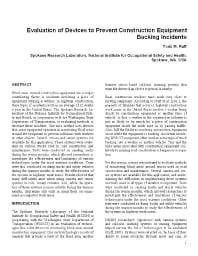Mining Publication: Evaluation of Devices to Prevent Construction Equipment Backing Incidents
Original creation date: October 2004
Authors: TM Ruff
NIOSHTIC2 Number: 20033010
SAE Commercial Vehicle Engineering Congress and Exhibition (Oct. 26-28, 2004; Chicago, IL). Paper 2004-01-2725; :10 pp
Blind areas around construction equipment are a major contributing factor in incidents involving a piece of equipment striking a worker. In highway construction, these types of incidents result in an average of 22 deaths a year in the United States. The Spokane Research Laboratory of the National Institute for Occupational Safety and Health, in cooperation with the Washington State Department of Transportation, is evaluating methods to decrease these incidents. One such method uses devices that assist equipment operators in monitoring blind areas around the equipment to prevent collisions with workers or other objects. Several camera and sensor systems are available for this application. These systems were evaluated on various trucks used in road construction and maintenance. Tests were conducted on sanding trucks during the winter months, which allowed researchers to investigate the effectiveness and limitations of various technologies under the most extreme conditions. Tests were also conducted on dump trucks and utility vehicles during the warmer months to study the effectiveness of the systems in highway work zones. Results showed that many difficulties arise when using camera and sensor systems in cold, snowy climates. And, while the operation of these systems is more reliable during the warmer months, challenges still exist in using them on equipment in congested work areas.

NIOSHTIC2 Number: 20033010
SAE Commercial Vehicle Engineering Congress and Exhibition (Oct. 26-28, 2004; Chicago, IL). Paper 2004-01-2725; :10 pp
- Acceleration and GPS Data Monitor Truck-Haulage Jolts
- Characteristics of Fugitive Dust Generated from Unpaved Mine Haulage Roads
- Fatigue Management for Haul Truck Drivers: A Low-Tech Solution for a Small Mine
- Mutagenicity of Diesel Exhaust Particles from an Engine with Differing Exhaust After Treatments
- Programmable Electronic Mining Systems: Best Practice Recommendations (In Nine Parts): Part 2: 2.1 System Safety
- Programmable Electronic Mining Systems: Best Practice Recommendations (In Nine Parts): Part 8: 6.0 Safety File Guidance
- Programmable Electronic Mining Systems: Best Practice Recommendations (In Nine Parts): Part 9: 7.0 Independent Functional Safety Assessment Guidance
- Surface Haulage Truck Research
- Test Results of Collision Warning Systems for Surface Mining Dump Trucks
- Tying Acceleration and GPS Location Information Together To Create a Mine Management Tool